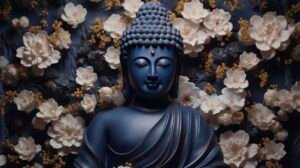Table of Contents
ToggleWhat is an Aura?
An aura is like a colourful, invisible glow around a person that some people believe can reflect their emotions and energy even though it can’t be seen with the naked eye.
For example, Imagine you’re sitting next to a person, and you sense that they have a warm and friendly “vibe” or aura about them. You feel comfortable in their presence, even though they haven’t spoken. In this context, The human aura refers to the positive and welcoming energy or atmosphere surrounding that person. It’s as if there’s an invisible glow of friendliness around them, which you can feel even without them explicitly showing it through their actions or words.
This is a simplified way of understanding the concept of a human aura as it’s often described in some spiritual and esoteric beliefs. People who believe in auras might suggest that this “vibe” or energy field expresses the person’s inner emotions and character.
In this blog, Hidden Mantra explores auras – what they are and what their power means. We are on a journey to discover the secrets of these invisible energy fields that surround us all. Whether you’re just curious or already fascinated by auras, this blog is here to help you understand and connect with this fascinating aspect of life.
Join us as we learn about auras and how they can bring insight, empathy, and personal growth into your life. Get ready to learn the hidden world of auras, where the unseen becomes known.
What Are Auras?
Auras are like colourful, invisible glows around people. These glows aren’t something you can see with your eyes, but some believe they can tell us about a person’s feelings and personality. Think of them as invisible mood rings!

Why Are Auras Important?
Understanding auras can help us connect with others better. For example, if someone has a friendly aura, you might feel comfortable around them. If their aura seems tense, you might want to approach them with care. Auras are like unspoken signals about how someone is feeling.
History of Aura
People have been talking about auras for a long time. Different cultures and traditions have their own ideas about auras and what they mean. Some think auras reveal a person’s spiritual side, while others see them as a way to understand emotions.
Exploring the history and cultures that have believed in auras can give us a better picture of why they matter to some people today.
The concept of auras has a diverse and complicated history, with variations in beliefs and interpretations across different cultures and time periods. Below a simplified overview of the history of auras:
Ancient Civilizations
The belief in auras dates back to ancient civilizations. In ancient Egypt, for example, it was thought that a person’s aura or “ka” represented their spiritual essence and continued to exist after death. Similarly, ancient Indian texts like the Vedas mention the idea of auras, associating them with the body’s energy and spiritual well-being.
Ancient Greece
The ancient Greeks believed in the “aureole,” a radiant light or halo that surrounded divine figures like gods, heroes, and emperors. This concept of auras as divine halos has influenced art and religious symbolism throughout history.
Theosophy
In the late 19th and early 20th centuries, the Theosophical Society, founded by Helena Blavatsky and others, played a significant role in popularizing the idea of auras in Western esotericism. They proposed that auras were subtle energy fields that could reveal a person’s spiritual and psychological condition.
New Age Movement
Auras gained prominence during the New Age movement of the 20th century, with various practitioners and authors exploring and teaching about aura reading, aura photography, and the meanings of different aura colours. This era saw a surge of interest in the spiritual and healing aspects of auras.
Contemporary Beliefs
Today, the belief in auras remains popular among individuals interested in spirituality, holistic healing, and alternative medicine. Many people consult aura readers or energy healers to gain insight into their emotional and energetic states.
It’s important to note that the concept of auras lacks empirical scientific evidence and is primarily considered a belief system within the realms of spirituality and metaphysics. Beliefs about auras can vary widely from one person or tradition to another, and their significance is subjective, often tied to personal and cultural perspectives.
The Colors of Auras
Auras, like colourful glows around people, can come in various shades, and each colour may carry its own meaning:
Red
A red aura often indicates a person with lots of energy, passion, and determination. They may be dynamic and assertive.
Blue
Blue auras suggest a calm and peaceful nature. People with blue auras are often seen as thoughtful, compassionate, and good communicators.
Green
Green is linked to qualities like healing, growth, and balance. Those with green auras are thought to be nurturing and in harmony with nature.
Yellow
Yellow auras are associated with optimism, creativity, and a cheerful disposition. Individuals with yellow auras are often seen as joyful and imaginative.
Purple or Violet
These colours represent spiritual awareness, intuition, and a deep connection to the mystical. People with purple or violet auras may be spiritually inclined and highly intuitive.
Orange
An orange aura suggests enthusiasm, vitality, and a zest for life. Those with orange auras may be outgoing and energetic.
Pink
Pink auras reflect love, affection, and a gentle nature. People with pink auras are often considered loving and empathetic.
White
White is associated with purity, clarity, and a strong connection to higher spiritual realms. Individuals with white auras may be spiritually advanced or pure of heart.
Brown
A brown aura might indicate someone who is grounded, practical, and down-to-earth. They are often seen as stable and reliable.
Gray
Gray auras can signify neutrality and compromise. People with gray auras may be diplomatic and able to see both sides of a situation.
Black
Black auras can represent protection or the need for transformation. They don’t necessarily mean something negative. Instead, they might indicate a need for change or shielding from negative energies.
It’s important to remember that these interpretations are not universally agreed upon, and the meaning of aura colours can vary among different belief systems and individuals. Exploring aura colours can be a fascinating way to understand people’s emotions and energies, even if it’s not scientifically proven.
How to See and Feel Auras
In this section, we’ll explore how you can try to sense auras, those invisible glows around people. Remember, not everyone can do this, but it can be a fun experiment.
Techniques to Sense Auras
Soft Focus – One way to start is by looking at a person with “soft” or relaxed eyes. Instead of staring directly at them, focus on a point just beside them. You might start to notice a faint glow or color around their body.
Peripheral Vision – Another technique is to use your peripheral vision, which is the part of your vision on the sides. Gaze slightly to the side of the person you’re trying to sense, and you might see something in your side vision that you can’t see when looking straight at them.
Feeling Auras
Close Your Eyes – Sometimes, you can sense auras better when your eyes are closed. Try sitting or standing near someone and closing your eyes. Pay attention to the energy or feeling you get when you’re close to them.
Use Your Hands – Hold your hands close to someone without touching them. Move your hands slowly up and down, closer and farther away. You might feel a subtle change in temperature or a slight tingling sensation when you get closer to their aura.
Practice Aura Exercise
- Find a quiet space with good lighting.
- Ask a friend or family member to stand or sit comfortably in front of you.
- Relax and take a few deep breaths to clear your mind.
- Use one of the techniques mentioned above to try and sense their aura.
- Pay attention to any colors, sensations, or feelings you experience.
- Afterwards, compare your observations with the person to see if they match or make sense to you.
- Remember, seeing or feeling auras might take practice, and not everyone can do it. But it’s a fun way to explore your own senses and how you perceive the world around you.
The Significance of Aura Colors
Now that we’ve talked about aura colors, let’s explore what these colors might reveal about a person and how to understand them.
What Aura Colors Can Tell Us:
Red – If someone has a red aura, it could mean they have a lot of energy and passion. They might be excited or even a bit agitated. It’s like a burst of enthusiasm.
Blue – A blue aura suggests calmness and thoughtfulness. People with blue auras often have a peaceful nature and are good listeners.
Green – Green is about healing and kindness. Those with green auras are often nurturing and care deeply about others and nature.
Yellow – Yellow auras often mean happiness and creativity. These people are usually cheerful and have bright ideas.
Purple or Violet – These colors suggest spirituality and intuition. People with purple or violet auras might be more connected to their inner selves and have a deep understanding of things.
Interpreting Aura Colors
Combination Colors – Sometimes, a person’s aura might have more than one colour. This can show that they have a mix of qualities. For example, a green and yellow aura might mean someone is both kind and creative.
Color Intensity – The brightness or intensity of a colour can also matter. A very bright red might indicate intense energy, while a soft blue could suggest a gentle nature.
Changes in Colors – Auras can change depending on a person’s emotions or health. If someone usually has a blue aura but suddenly it turns red, it might mean they’re feeling stressed or excited.
Personal Interpretation – Remember that aura reading is not an exact science, and interpretations can vary from person to person. What’s most important is how you feel when you sense these colours.
Understanding aura colours can be a fun way to connect with others and gain insight into their emotions and personalities. It’s like having a colourful window into the world of feelings and energies.
Also Read: Kundalini Yoga and Meditation: A Powerful Combination
The Practical Applications of Auras
So, We learned about auras and what they can tell us. Now, let’s see how this knowledge can actually be useful in our daily lives.
How Understanding Auras Helps
Better Relationships – When you can sense someone’s aura, you might understand them better. For example, if a friend has a blue aura, you’ll know they appreciate calmness. So, you might choose a quiet place for a chat instead of a noisy one.
Improved Communication – Knowing aura colors can help you communicate effectively. If you’re working on a project with someone who has a red aura (lots of energy), you can suggest more active tasks to keep them engaged.
Emotional Awareness – Auras can give you clues about how someone feels, even when they don’t say a word. If you sense a gray aura around a friend, it might mean they’re feeling unsure. You can then offer support or a listening ear.
Tips for Everyday Life
Observe Calmly – When you meet people, try to observe their aura colors calmly. Don’t jump to conclusions; just be open to what you sense.
Practice Empathy – Use your aura knowledge to practice empathy. If you sense someone is stressed (maybe a reddish aura), be understanding and offer help if they need it.
Self-Reflection – Understanding your own aura can help with personal growth. If you notice that you often have a yellow aura (associated with happiness and creativity), it can encourage you to explore your creative side more.
Aura Cleansing – Some people believe in cleansing their auras to get rid of negative energies. You can do this through meditation, spending time in nature, or with the help of a trusted energy healer.
Debunking Myths and Misconceptions
Sometimes, people have doubts or misunderstandings about auras. Let’s clear up some of these myths:
Myth 1 – Auras Are Scientifically Proven:
Some people claim that auras are scientifically proven, but in reality, there isn’t solid scientific evidence to support their existence. Many scientists view auras as part of metaphysical or spiritual beliefs.
Myth 2 – Everyone Can See Auras:
Not everyone can see or sense auras. It’s a bit like having a unique talent. Some people might have a natural ability, while others may need to practice and develop it.
Myth 3 – Aura Colors Are Always the Same:
Auras can change based on a person’s emotions and state of mind. They’re not fixed. For example, someone with a green aura may show a different color when they’re feeling excited.
Myth 4 – Auras Only Have Positive Meanings:
Aura colors don’t necessarily indicate only positive traits. For instance, a red aura could suggest energy and determination, but it might also mean someone is feeling agitated.
Myth 6: Auras Predict the Future
Auras are more about understanding a person’s current state of mind and emotions, not predicting the future. They’re like a snapshot of the present moment.
It’s essential to approach auras with an open mind and remember that they are largely based on belief systems. While some people find meaning and insight in aura readings, others may view them as a form of spiritual or personal exploration rather than scientifically proven phenomena.
In the realm of auras, the Hidden Mantra comes to life, where invisible glows unveil the colourful tapestry of human emotions and energies. While the science may be debated, the impact is undeniable. Understanding auras can foster better relationships, empathy, and self-awareness. So why not take a moment to explore this captivating cultural and spiritual domain, guided by the Hidden Mantra’s wisdom? Try sensing auras, practice empathy, or simply embrace the idea that there’s more to our interactions than meets the eye. After all, auras remind us that the world is not just black and white but a vibrant spectrum of emotions waiting to be discovered through the Hidden Mantra’s guidance on your journey of self-discovery and spiritual enlightenment.
Also Read: What is Chakra Meditation
Frequently Asked Questions
What is an aura?
An aura is an invisible energy field around a person that some believe reflects their emotions and personality.
Can everyone see auras?
No, auras are not visible to the naked eye, but some claim to sense or see them through practice.
What do different aura colors mean?
Each color is believed to represent different traits, like red for passion, blue for calmness, and green for healing.
Can auras change over time?
Yes, auras can shift based on emotions, health, and personal growth.
How can I sense an aura?
Some people try techniques like soft focus, peripheral vision, or feeling energy with their hands.
Is there scientific proof of auras?
No, auras are a spiritual belief with no scientific evidence to support them.
What does a black aura mean?
A black aura is often linked to protection or emotional heaviness, not necessarily negativity

















